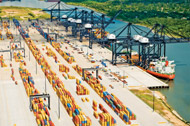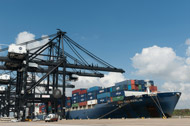| FEATURE ARTICLE, MAY 2012
HOUSTON: AMERICA’S DISTRIBUTION CENTER
A Port of Houston Authority executive discusses expansion, steel and the Panama Canal.
Compiled by John Nelson
John Moseley, general manager, trade development of Port of Houston Authority (POHA), spoke recently with Texas Real Estate Business about some of the port’s programs and accolades, as well as the port’s impact on Houston and the rest of the state. Following are the highlights.
TREB: Where is the volume of the Port of Houston at now and where has it been?
 |
The Port of Houston Authority’s new tagline is “Houston: America’s Distribution Center.” Averaging $1 billion in capital expenditures every 5 years, the Port of Houston is poised to live up to its billing. |
|
Moseley: The Port of Houston is the largest in the country by foreign tonnage, and the Port of Houston region exceeds 220 million tons. For The Port of Houston Authority as an entity, last year 42.44 million tons crossed our docks, a 5 percent increase over 2010. In 2011, our steel volumes were up 58 percent over the prior year, and that’s just for POHA. That ranks us as the largest in the U.S. in terms of foreign tonnage and the largest in steel.
POHA operates the only container terminals in Houston, so there’s probably a very minimal number of TEUs that move through private terminals. In terms of containers, we rank as the eighth largest container port in the U.S. with nearly 1.9 million TEUs moving across our gateway. We rank as the fourth largest container terminal on the Eastern Seaboard (between East Coast and Gulf Coast). We rank as the largest port in the Gulf of Mexico. We have roughly 68 percent of the market share for all containerized cargo in and out of the Gulf. That’s all rankings based on container numbers.
TREB: What expansion/renovations are being done to the Port of Houston?
Moseley: We spend about $1 billion every 5 years in terms of capital expenditure projects. It’s a huge undertaking because we own roughly 22,000 acres in and around the Houston Ship Channel and operate eight cargo terminals. That includes everything — submerged and above water. About half is reclaimed dredge sites and underwater areas we control but the other half (roughly 11,000 acres) are green sites and developed sites for cargo operations. The improvements fall into two basic areas: general cargo wharves and container facilities.
In terms of general cargo areas, we’re doing things like expanding the lay down area for steel and oil and gas project cargo, building new wharves, improving and expanding roads, opening new gates and installing new systems. For example, we’ll have $18 million worth of expenditure this year and next year just for improving roads that come through the main entrance. We’ll also be laying out concrete on an additional 18 acres adjacent to Wharf 32 on our turning basin. Essentially, working to ensure we continuously maintain a fluid environment for cargo movement as business continues growing year to year.
TREB: How does the Port go about securing funds?
 |
An executive with The Port of Houston Authority discusses how Houston is becoming “America’s Distribution Center.” |
|
Moseley: Our operations are self financed. In terms of new infrastructure development and dredging, we combine our own resources with those of local and federal sources. We have our challenges like many entities do, but the difference here is that the Port of Houston contributes approximately 785,000 jobs across Texas, directly and indirectly — 1.5 million jobs nationwide according to our last estimate about 5 years ago. With those credentials, we work to get the attention needed, and we have a track record of getting the job done.
TREB: What advantages does the Port of Houston have over its competitors?
Moseley: There are a couple really strong advantages. We’re not like a West Coast port, which are so dependent on imports and trans-Pacific business, and we’re not an East Coast port, which are really driven by trans-Atlantic business. Being where we’re at, our central location, we’re very diversified. We serve all three major trades, whether its trans-Pacific Asia, East-West Trans Atlantic or North-South Inter Americas business like Brazil. Houston is situated in a great location with room for growth.
TREB: Are the West Coast ports worried about losing business with the expansion of the Panama Canal?
Moseley: (The Inland Empire) is our No. 1 competitor when it comes to Asian business and when it comes to the fastest growing trade (trans-Pacific). We’d be very happy to divert as much cargo that is now going through the railroad and being delivered to the Port of Houston. That’s a very big deal. The West Coast ports are definitely concerned about the Panama Canal expansion and have been for 10 years because their market share has gradually eroded. It’s been a trend over the past 10 years since the lockout/shutdown in 2002 that volume has been shifting away from West Coast ports to East and Gulf coast ports, like Houston.
What’s interesting about the Gulf Coast ports compared to others is that we’re actually very collaborative. We have an initiative that we’ve called the Gulf Coast Advantage, whereby we’ve teamed up with the Port of Mobile and the Port of Tampa and the three of us are out marketing and trying to attract services to the Gulf as a region. You don’t see that kind of collaboration anywhere else. We figured that Mobile is a little too far east to really compete with us and Tampa is way on the other side of the Gulf so really they’re not a threat. Together, if we combine our efforts, we could successfully build some business for all three of us to enjoy. If an ocean carrier were to operate a dedicated service to the Gulf Coast, they’d have plenty of business and they wouldn’t have to add calls to the East Coast; they could just call our three ports and return through the Panama Canal with full ships. It’s a large enough market to support dedicated Gulf services.
©2012 France Publications, Inc. Duplication
or reproduction of this article not permitted without authorization
from France Publications, Inc. For information on reprints
of this article contact Barbara
Sherer at (630) 553-9037.
|
